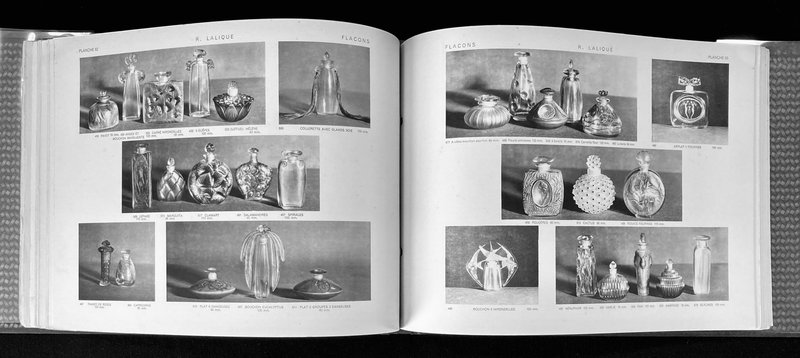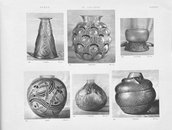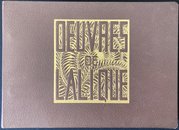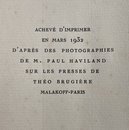Catalogue des Verreries de René Lalique

[GLASSWORK.] Lalique, Réne. Catalogue des Verreries de René Lalique.
Paris: René Lalique & Cie, March 1932.
(34.5 x 25 cm). Oblong. [2], V, frontispiece, 122 plates (117 numbered and 5 unnumbered), [2], 27 pp (priced index). Publisher’s deep brown, title emblem in gilt on the front board, patterned pastedowns, metal bracket holding the leaves. A fine copy. From the colophon: printed in March 1932, after photographs by P. Haviland, on the presses of Théo Brugière, Malakoff-Paris. Given that the catalog is bound so that plates may be easily removed or substituted, we offer the following collation for clarity: [1] 1-29 [30] 31-39 [40] 41-50, 49-50 bis [1] 51-60 [1] 61-88 [1] 89-100 [1] 101-115 [plates 103-104, 111-115 are indicated “Supplément planche”], i.e., 122 photographic plates, most of which are printed on both sides of the leaf.
The celebrated and exceedingly rare catalog with striking photographs by Paul Haviland (1880-1950), elegantly presented in a publisher’s binding, likely made by René Kieffer. This copy is enriched with an autograph letter signed by René Lalique.
FOR THE FULL DESCRIPTION: Lalique 1932
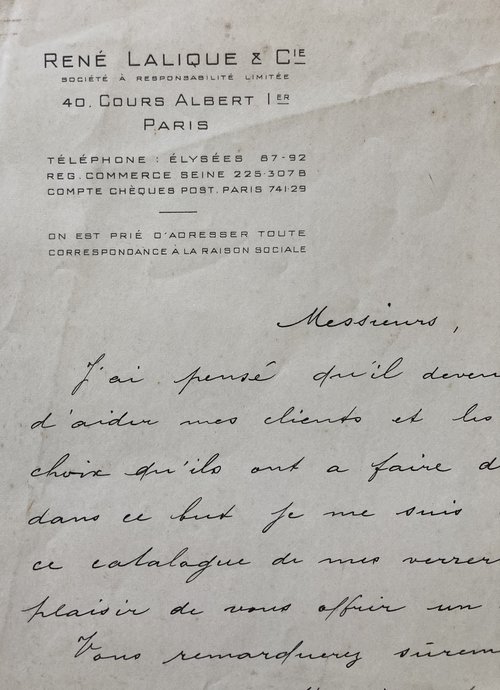
Extensive documentation of the great Art Deco glassmaker:
A rare and significant trade catalog for 1932, displaying approximately 1,500 elegant pieces of Lalique’s sublime glassware in equally stunning photographs by his son-in-law Paul Haviland. Included are a magnificent array of vases, bowls, boxes, colognes and other bottles, dresser sets, mirrors, statuettes, ashtrays, picture frames, paperweights, clocks, jewelry, decanters, liquor sets—enough to make Oscar Wilde swoon. The volume is known with varying numbers of plates, but the nature of the binding, with its quick-release metal clasp, was made for the removable of individual plate for the purpose of updating the catalog. Our copy is complete in that there are no gaps in the plate numbers and the plates all correspond to the detailed index of individual items.
Lalique: a bridge between Art Nouveau and Art Deco:
René Lalique (1860-1945), began his career as a jeweler, in the Art Nouveau style. As an artist, his work was displayed alongside Monet, Manet, Rodin, and Vuillard, and he came to be seen as the successor to Emile Gallé (1846-1904), the great master glassmaker who inaugurated the Art Nouveau style. After a transition, Lalique’s glasswork came to be regarded as the finest in the industry, an innovator in both design and production, he is believed to be the first glassmaker to use the last-wax technique. From the time of his successful 1912 exhibition at 24, Place Vendôme, he held a superior position as a glass maker. By the 1920s his style moved toward that which that typified and defined Art Deco, a style strongly evident in this catalog.
The photographer Paul Haviland (1880-1950), was the son of Charles Haviland (1839-1922), director of the Haviland and Co. factory, Limoges, and Madeleine Burty (1860-1900), daughter of the writer and critic Philippe Burty (1830-1890), who grew up immersed in art, music, and literature. Renoir painted young Paul’s portrait as a child and he later met Alfred Steiglitz in New York, assisting him in establishing the 291 Gallery, and with whom he formed an important friendship. From 1909, Haviland wrote regular articles for Steiglitz’s Camera Work, but returned to France in 1916 to help his father with the family business. In 1917 he married Suzanne Lalique, a set designer for the Comédie-Française and the daughter of René Lalique.
The author of the introductory essay on Lalique is by Gabriel Mourey (1865-1943), a French writer, translator, and art critic, and an important promoter of the Pre-Raphaelites and the Arts and Crafts movement in France.
